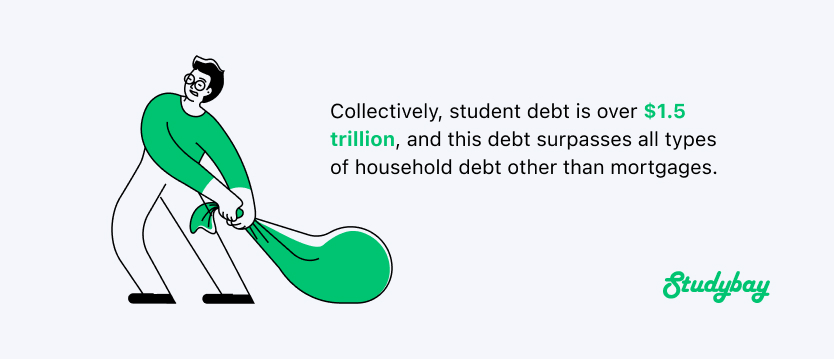
24 min
8
10.04.2022

So, what set of circumstances normally prompts a student to try ghostwriting services? What are they trying to achieve? And what is the typical demographic profile of the students who most commonly decide to use these services?
- The Stress of Being a College Student Today
- Why Students Decide to Try Ghostwriting Services
- The Time Investment of the Typical Student
- The Culture Shock of the College Classroom
- The Stress of Homework for a Typical College Student
- Ghostwriting Services Are Different Today
- Is Purchasing Ghostwriting Services the Same as Plagiarism?
- The Effects of College Stress Can Be Extreme – Even Life Threatening
- So, What Does a Typical Purchaser of Ghostwriting Services Look Like?
- How Are Teachers Affected by Ghostwritten Submissions?
- The Effects of the Student Debt Crisis
- Conclusion
These are the questions this article will answer. We'll do this through an in-depth statistical analysis, a comprehensive psychological evaluation, and even a few first-person perspectives from the points of view of both teachers and students. This will help us gain a more personal perspective of the factors that influence the work ethic and study habits of modern students.
The Stress of Being a College Student Today
Let's face it. The world can be a cruel place. Nowhere is this truer than in the semi-segregated universe of academia. So much is this true here in the 21st-century collegiate world, that nationally accredited universities across the globe are starting to take notice as well. From the 2021 national study Depression, Anxiety, Loneliness Are Peaking in College Students, co-led by Boston University researcher Sarah Ketchen, we learn that the levels of strife amongst today's college students are not only increasing; the study points to the probability of a continuous, and even escalating cycle as time progresses.
Other recent studies have suggested that among the key instigators of stress among college students is the tremendous burden of the workload they are required to shoulder, particularly during their early undergraduate years. Perhaps more compelling is the unveiling of new research that suggests much of the work students are required to complete during those bachelor years may be largely worthless. James Stillwaggon, Professor of Philosophy at Iona College, who witnessed that some of his students used ghostwriting as a way to earn money, believes that students' choice to pay for their homework "is a reflection of how they are graded on generic questions that have nothing to do with their own experiences of the world."
Due to the named stressors, an increasing number of students are turning to the concept of purchasing individualized ghostwriting services such as essays, reports, and term papers, to meet the rubrical requirements of increasingly demanding professors.
Why Students Decide to Try Ghostwriting Services
Many studies are showing that the practice of utilizing ghostwriting services is becoming increasingly widespread. This is probably because it alleviates much of the mental health burden of having to research and craft tediously long papers, especially for classes that are not directly relevant to their declared major.
In a March 11, 2022 article titled 7 Strong Reasons Why Students Buy College Essays, author Gregory France of the online advisory site FedRegsAdvisor.com, confirms all of these assertions. Among other things, he cites that a heavy workload, a challenging personal life, and increasingly difficult assignments, are the top three reasons why students the world over are deciding to take advantage of this rapidly growing business niche.
Also, in a 2019 article published on BusinessInsider.com, Bill Loller, the Vice President of Product Management for the academic plagiarism-catching software Turnitin, which provides cheating-detection services to more than 18,000 learning institutions globally, had this to say:
There's a whole economy around this. Hundreds of millions of dollars are being spent on it.
The article goes on to say that an estimated 31 million students have already made the decision to partake in the practice of purchasing ghostwriting services, and that number is only expected to increase in the coming years.
A group called "Deans for Impact" recently published a report explaining the importance of keeping schoolwork compelling. In their report, Content of Thinking – Rigorous Tasks, the group explains that along with other elements, making sure that the content students are required to process remains both rigorous and relevant is paramount to maintaining engagement.
This is important for students of all ages, but particularly for college students, since their levels of distraction are much higher and far more acute than those of elementary or even middle school students who have yet to face the pressures of dating, complex personal relationships, after school jobs, or any host of other distractions and stressors inherent in young adult life.
The Time Investment of the Typical Student
In his report, The Influence of Home on School Success, John H. Wherry does an excellent job of demonstrating the math necessary to determine how much time, in waking hours, an average American student spends — both in class and doing homework — before the age of 18. He worked it out to the age of 18 because that's the age most students advance to begin their unique collegiate journeys.
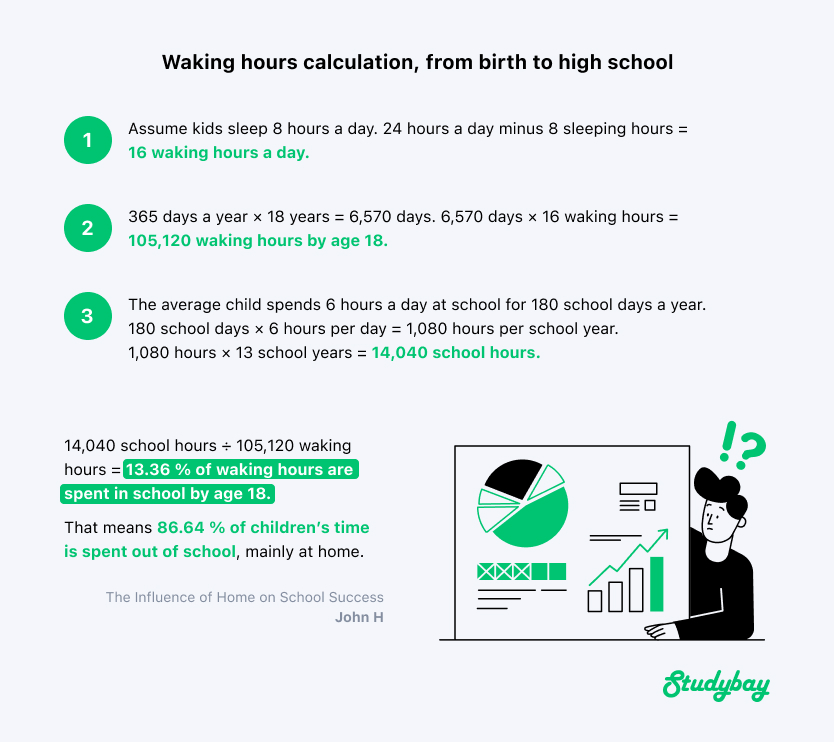
As it turns out, according to Wherry, the typical American student spends about 1,080 hours in school per year. When we multiply that by the 13 years from kindergarten through grade 12, we see that it equates to around 14,040 hours of classroom time to get through the system on a normal public-school program.
Wherry also explains that by the same age, after deducting for average daily sleeping time, an 18-year-old entering college has been awake for approximately 105,120 hours. This is important because, when we contrast the number of normal classroom hours which we have already calculated, to the total number of hours a typical 18-year-old spends being awake, we can extrapolate that around 13.36% of an average young person's waking hours are spent in the classroom, often learning boring and mundane facts and figures, all before the tender age of 18.
The "Deans' study focuses on college students because of the number of hours they are required to devote to their respective academic tasks. The Deans proffer that if academic tasks amount to little more than the regurgitation of disassociated facts that do not build on the skills or knowledge they've already stored, students are much more likely to "zone out' and begin to disregard what's being presented to them.
When this happens, grades often drop, and stress increases exponentially, sometimes even to catastrophic levels, hence the high rate of collegiate suicide.
The Culture Shock of the College Classroom
In a highly comprehensive article titled How IS College Different From High School, King's College of Wilke's Barre, Pennsylvania, explains the breakdown of classroom vs. homework hours that a new student can expect to devote to their studies in order to have a reasonable chance of success.
Of key importance here is the fact that they differentiate the transition from the 30-hour average weekly classroom schedule of a high school student, with the 12–16-hour weekly classroom schedule of a typical college freshman. Also of particular importance in that article are the differences in class size, time management, and homework.
For sure, class size in college can be drastically different than in high school, which is rigorously limited by numerous local, state, and federal laws. In college, there are no such regulations. Because of that, if the college is large and the class is either popular with students or is a required "core class," collegiate classroom sizes can run as high as several hundred students. This causes issues both for students and teachers: the first group feels lost and confused while facing difficult assignments one on one, while the second simply has no opportunity to find an individual approach for each learner. That's why they end up assigning more formulaic tasks and have less time to spend on homework checking. In the opposite situation, more formulaic professors have far more time to spend looking through each student assignment. When talking about his workload, Robert Bishop admits, "This is easier for me to do as my classes tend to be small. Tracking and comparing the writing style of 10-15 students is much easier to do it for 30-40!" In such a low-stress atmosphere, a professor can find an approach to everyone in their class, but when it comes to groups with a large number of students, difficulties may arise.
Of particular importance in affecting a student's stress level, is the new scholastic time management regimen they must quickly develop, implement, and adhere to if they are to be successful in the collegiate atmosphere. That's because, in high school, a student's day is by and large completely planned out and basically fed to them by the school administration. Once in college, however, each student's schedule and movements become entirely of their own volition.
Effective time management is an important and often highly intricate skill set that more than a few highly paid executives never manage to master. For a transitioning college student who was simply never taught or explained the nuances of the processes involved, this self-disciplined, time-management "culture shock,' could be downright traumatizing.
The Stress of Homework for a Typical College Student
All the elements we just evaluated are surely cause for a substantial amount of stress for any new college freshman, but perhaps the greatest novel factor new collegiate students must face while transitioning to college life is the reality of the homework disparity between high school and college.
To sum it up briefly, though the King's College article is much more thorough in addressing each of these elements, in high school, blowing off a homework assignment is almost never too big of a deal. In college, however, homework is often where 85-90% of the information transfer takes place (depending on the style of each professor). This often translates into failing grades for people who are not disciplined enough to instinctually improve their reading, study, and homework habits.
To put it succinctly, the stress and anxiety of homework self-discipline, compounded by the stressors of developing previously unheard-of time management skills, and often attempting to take notes while in classrooms of 100 or more students, all from a professor who will often only help during their designated office hours, frequently leads to serious mental health issues among students.
What's more, these factors are organic to the college lifestyle and speak nothing of the students who start college financially strapped and must work (often two or more jobs) to pay their way through school.
Connor Mullins of the school Newspaper, The Optimist, wrote an excellent piece back in February of 2022 which addresses these issues quite well. In his article, Why College Students Get Burnt Out and Why it Should be Prevented, he cites numerous additional sources that support the assertion that lifestyle changes, unhealthy eating practices, poor sleeping habits, and so many other factors which are less quantifiable, but which often combine with the other elements, make an otherwise good student feel overwhelmed or even inadequate, or stupid.
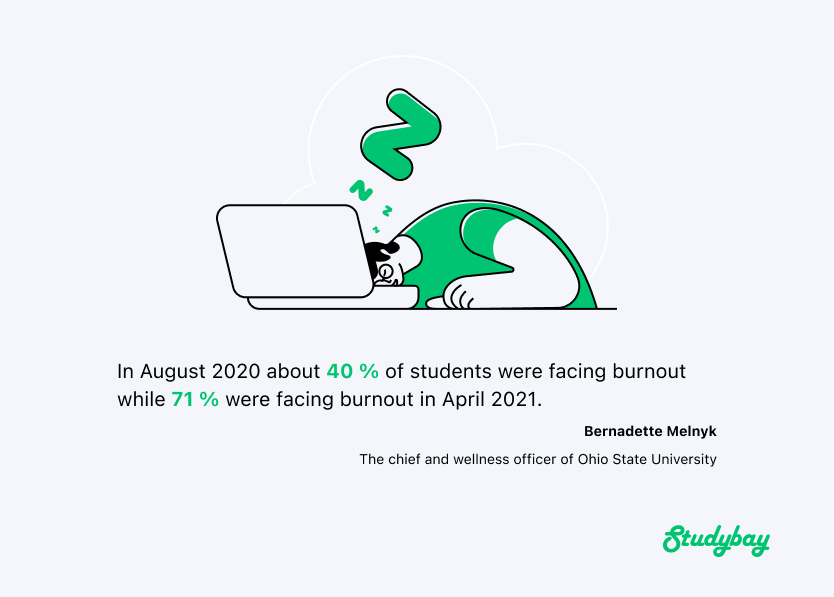
Ghostwriting Services Are Different Today
To be sure, there is a myriad of reasons and rationales for students to buy newly ghostwritten college papers. This is an important distinction to make since the concept of "essay banks' is nothing new. In fact, Wikipedia does an excellent job explaining the history and origins of the practice of using "term paper mills," or "paper reservoirs" as they were once commonly called, dating back to the mid-nineteenth century.
In those days, however, it was nearly impossible for college professors to catch plagiarists. Unless a student had the misfortune of submitting a paper that the same professor had already graded for someone else, the chances of getting caught for using a recycled paper sat somewhere between "slim' and "none.'
Today, many types of plagiarism checkers exist and are at the disposal of every college professor. Web Applications like the popular plagiarism tracker Turnitin, allow professors of every ilk to scan vast databases of stored, previously turned-in academic papers, looking for matches against newly submitted work.
Years ago, a single term paper or essay could be recycled literally dozens, if not hundreds of times. In today's college environment, using a pre-crafted paper even a second time is risking severe disciplinary action from the learning institution--up to and including expulsion. Because of this, the practice of using a "term paper bank," or mill if you prefer, has been rendered obsolete, if not academically suicidal. It's proved by Robert Bishop, Professor of Physics and Philosophy at Wheaton College:
I currently use Turnitin software to check plagiarism. This software checks databases both inside and outside my institution and compares a student's submitted paper for any similarity to any others in the database. I have caught one student submitting an identical paper to one submitted in a previous year. This student admitted that they borrowed the paper from a friend who took the class the previous year.
Enter the concept of specifically unique ghostwritten paper writing.
In this modern iteration of the "term paper mill" concept, companies with vast banks of experience and knowledge at their fingertips are hired to craft new and unique papers designed to meet the specific requirements of that individual professor's provided rubric. The result? A quality paper that was written to meet each of that professor's requirements and which has never been presented for an academic grade before—anywhere. This means the newly created paper is 100% invisible to every plagiarism checker there is.
Is Purchasing Ghostwriting Services the Same as Plagiarism?
According to the resources we found, as well as the exercise of our own common sense, the answer is an emphatic no. That's because plagiarism is the act of replicating someone else's work and presenting it as your own. When referring to modern ghostwriting services, this is not the case. Today, the student purchasing ghostwritten papers is paying for the creation of unique, newly authored work. The student then pays the originator of that work for its exclusive rights of ownership and, as such, now legally owns the authorship and possesses the only copy of the work.
In this situation, since there is no record of prior or subsequent publication under any name other than that of the purchaser, the piece is now legally considered the buyer's own. This situation is completely analogous to ghostwritten music, books, and song lyrics which are often uncredited to the actual constructor of the piece. Once the transfer of funds is complete, the legal transfer of exclusive ownership is also complete and all rights of ownership are transferred to the purchaser.
The Effects of College Stress Can Be Extreme – Even Life Threatening
In a February 8, 2016 piece published on PsychReillience.com, the staff at Psychology Today wrote an incredible article called: Student Stress, Anxiety & Depression: Bureaucratic Barriers at University Mental Health Services. In it, they write:
"The Nation recently reported that Yale University dismissed (euphemism for expelled) a graduate student who attempted suicide. The student, Grant Mao, a native of Shanghai, had plunged into an unexpected emotional crisis, spiraling into a deep depression following his mother's heart attack and a breakup with his fiancée. This led to a six-day stay in a hospital, but instead of the expected recovery and graduation, he was expelled, and his immigration status was jeopardized as he was threatened with deportation.
Yale's Mental Health Services are supposed to provide general psychiatric care for all students, but, in fact, are like other university mental health services throughout the nation, inadequate and steeped with bureaucratic barriers. Mao had managed to receive therapy while enrolled, but his academic downturn, he argues, resulted from incompetence and discrimination."
The article concludes:
"The take-away from Mao's case is that, until the bureaucratic barriers at university mental health services are removed and new therapies emerge, students cannot expect to find relief from their stress-related anxieties, depression, and self-destructive behaviors."
Another fantastic source, FinancesOnline, a global business review website, also published an intricate statistical analysis of the psychological trauma and day-to-day anxieties experienced by many high school and college students. In their very comprehensive case study: 54 Student Stress Statistics 2021/2022 Data: Bullying, Mental Health & Gun Violence, FO reports the following shocking statistics. (Note: for space considerations, this is only a partial list. It is recommended to read the entire piece from FO for full context and clarity)
- 58% of college students say they were "moderately," "very" or "extremely" concerned about their mental health. (Inside Higher Ed, 2020)
- 31% of students say that finals and exams are the biggest stressors, followed by worries over entering the workforce (24%), and mountains of coursework (23%). (WhatToBecome, 2021)
- Around 50% of college students are suffering from stress. (WhatToBecome, 2021)
- 48.3% of American college students who sought treatment suffered from anxiety, depression, or stress. Stress, in particular, accounted for 5.9% of the reported issues. (Statista, 2020)
- 75% of students have experienced a sense of "overwhelming anxiety" at some time, and 30% reported overwhelming anxiety during the last two weeks. (ACHA, 2019)
- 51.7% of college students have described academics as being traumatic or difficult to handle. (ACHA, 2019)
They even provide the following bar graph to accentuate the issue:
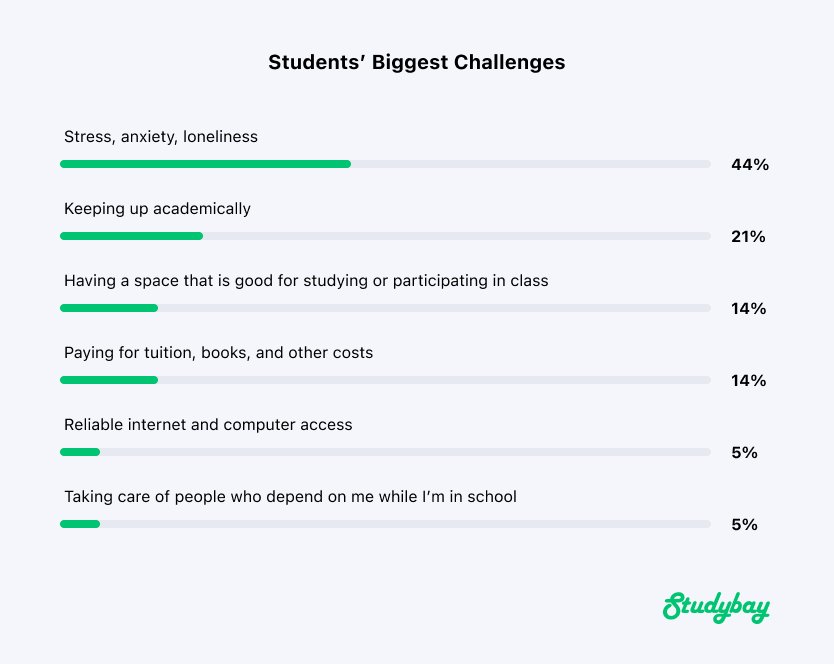
So, What Does a Typical Purchaser of Ghostwriting Services Look Like?
As it turns out, the most commonly shared characteristics of students who look to relieve at least some of their stress by purchasing ghostwriting services from reputationally reliable sources are:
- Students between the ages of 20-25 years old.
- Middle-aged students (35+) who work full-time jobs and are more financially secure but have little or no experience researching topics online.
- Students of color who have children, pets, and a house to care for. They are very good in their field but have little time to learn research methods.
- 90% of those who opt to utilize this service are American students (of all nationalities), though there are many from Europe, India, and China as well as other countries to a lesser extent.
- Most student ghostwriting customers appreciate their own privacy and resist asking others for help for fear of outwardly showing weakness.
- The overwhelming majority of these students are accumulating massive academic loan debt and realize how grave their personal financial situations would be if they were to drop out of college and still owe all of that money without even a degree to show for it.
- Most of them peruse the plethora of online platforms that offer academic ghostwriting services, select one, and remain loyal to that one throughout their academic careers.
How Are Teachers Affected by Ghostwritten Submissions?
Teachers are often left in the middle, smack dab between struggling students and the legal requirements of their profession. They are often considered the cause of student strife; however, the reality of it is that most teachers and college professors are mired in local, state, and federal regulations, as well as the academic policies of each institution, which tightly govern how lenient they can be with grading struggling students.
When asked how she deals with plagiarism and the other various methods many students are resorting to in an effort to alleviate at least some of the burden of their workloads, Dr. Sarah Elaine Eaton, an academic ethics professor, writes in her blog, Learning, Teaching & Leadership:
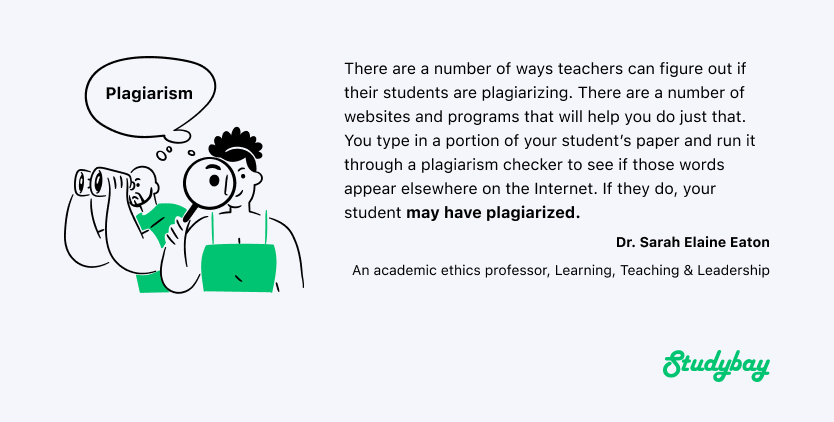
Put simply, if the plagiarism checker doesn't catch it, it most likely isn't plagiarism. That's because, as she also correctly states in her blog, even when the plagiarism catcher does flag potentially plagiarized content, it still may not be plagiarism.
Plus, both our collocutors Professor Robert Bishop and Professor James Stillwaggon, say they have their own specific protocol for vetting the factual aspects as well as the originality of open-ended student assignments. As Robert Bishop claims, he looks at students' writing styles to determine if they are consistent across the semester and if final essays show any differences from how the students wrote earlier. "I also require students to use materials that are only accessible through our online course management system for their assignments. This makes it harder for students to purchase a paper written by someone from outside the class," he says. James Stillwaggon shares his ways of working with students' assignments: "My assignments are usually very specific, they often involve in-person explanation and defense of a thesis, and they are often tied to autobiographical details. These aren't foolproof ways of avoiding ghostwriting, nor are any of them designed specifically to avoid ghostwriting, but they do tend to produce work that is closely tied to students' own experiences."'
The Effects of the Student Debt Crisis
As mentioned earlier, it is widely believed that stress, anxiety, and economic factors are the largest motivations for students deciding to use ghostwriting services. We've already addressed the first two, so let's close this article by examining the last one.
No matter how thorough we are here, in the form of an article, we could never do justice to the realm of information available regarding the current student debt crisis in America. While entire books have been and could still be written on this topic alone, an extremely in-depth article, presented by a unionized analytics company called AFT (aft.org) which deals with higher education metrics all around the country, released the following article. It details the intricate quagmire that is now commonly known as our national student debt crisis.
The complete article is excellent and bears reading, but, of primary concern for our purposes is this fact, quoted from within the article:
"Collectively, student debt is over $1.5 trillion, and this debt surpasses all types of household debt other than mortgages. Unlike holders of other types of consumer debt, who have experienced lower levels of delinquency and default since the Great Recession, student loan borrowers remain in distress.
Nearly 1 in 4 federal borrowers are in default or struggling to stay current on their loans. When they fall behind on their payments, the consequences are dire: negative credit reports, wage garnishment and diminished options to cure defaulted loans."
Those are some staggering numbers. Above all else, those crooked statistics, in their own right, are enough to cause ulcers, sleepless nights, and more than a little irritable bowel syndrome amongst already struggling students who are in danger of falling behind with their studies and possibly even dropping out of college altogether. It is certainly cause for such students, who may find themselves behind, often for the first time in their academic lives, to say to themselves, "I have to do whatever I can to make sure that doesn't happen to me."
Circumstances like these are often the first contemplation a student has of acquiring the assistance of ghostwriting services.
Yet another staggering report published by the analytics website USA FACTS (usafacts.org), published in April of 2021 and titled The Price of College is Rising Faster Than Wages for People With Degrees, states that:
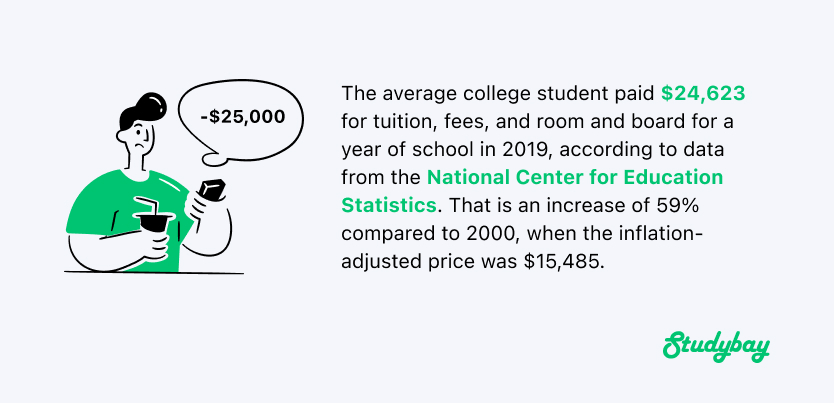
"The average college student paid $24,623 for tuition, fees, and room and board for a year of school in 2019, according to data from the National Center for Education Statistics. That is an increase of 59% compared to 2000, when the inflation-adjusted price was $15,485. Wages have not kept pace. Between 2000 and 2020, the Bureau of Labor Statistics reports that inflation-adjusted median weekly earnings for people with a bachelor's degree rose 5%.
Tuition for the average student across all types of institutions has risen faster than tuition for students at four-year or two-year colleges, where prices have increased 53% and 42%, respectively. Part of the rise in attendance cost is a shift towards four-year colleges."
Conclusion
Surely, those factual numbers are enough to stress anyone out, even under the best of circumstances. When we factor in the rest of the information we've covered in this article, it's pretty clear that today's college student is facing a considerable number of unique challenges that simply didn't exist in previous generations.
We now understand what types of students typically purchase ghostwriting services and why. As these challenges mutate and manifest themselves in numerous ways that weren't seen or dealt with in the past, it's no wonder students of all ages and backgrounds are looking for any edge they can find.
Many of those are opting to seek some small solace in the comfort of professional ghostwriting services to help ease the tremendous burdens of being a college student in the post-COVID era of 2022. Many of us can't say we blame them.
Reference List
- Are your students plagiarizing? Here’s how you find out. (2018, January 7). Learning, Teaching and Leadership. https://drsaraheaton.wordpress.com/2010/09/26/are-your-students-plagiarizing-heres-how-you-find-out/
- Boston University. (2021, February 17). Depression, Anxiety, Loneliness Are Peaking in College Students | The Brink. https://www.bu.edu/articles/2021/depression-anxiety-loneliness-are-peaking-in-college-students/
- Eira, A. (2022, January 14). With a finite number of hours per day and an endless array of to-dos, young people continue to get exposed to. Financesonline.Com. https://financesonline.com/student-stress-statistics/
- France, G. (2022a, July 30). 7 Strong Reasons Why Students Buy College Essays. Federal Regulations Advisor. https://www.fedregsadvisor.com/education/5089/7-strong-reasons-why-students-buy-college-essays/
- How is College Different from High School? | King’s College. (2015). Https://www.kings.edu/admissions/. https://www.kings.edu/admissions/hs_sophomores_and_juniors/preparing_for_college/high_school_vs_college
- Mullins, C. (2022, February 11). Why college students get burnt out and why it should be prevented. Optimist https://acuoptimist.com/2022/02/why-college-students-get-burnt-out-and-why-it-should-be-prevented/#:%7E:text=She%20stated%20that%20in%20August
- Student Stress, Anxiety and Depression: Bureaucratic barriers at university mental health services. (2016, August 2). Psychresilience.Com. http://www.psychresilience.com/archives/student-stress-anxiety-and-depression-bureaucratic-barriers-at-university-mental-health-services
- National Center for Education Statistics Table 330.10. (2020). Average undergraduate tuition and fees and room and board rates charged for full-time students in degree-granting postsecondary institutions, by level and control of institution: Selected years, 1963–64 through 2018–19. https://nces.ed.gov/programs/digest/d19/tables/dt19_330.10.asp
- Table 5. Quartiles and selected deciles of usual weekly earnings. (2021). Https://www.bls.gov/. https://www.bls.gov/webapps/legacy/cpswktab5.htm
- USAFacts. (2021, May 18). Is college worth it? The price of college is rising faster than wages for people with degrees. https://usafacts.org/articles/is-college-worth-it-the-price-of-college-is-rising-faster-than-wages-for-people-with-degrees/
- Wherry, J. H. (2004, September). The Influence of Home on School Success.
https://www.naesp.org/sites/default/files/resources/2/Principal/2004/S-Op6.pdf - Wikipedia (2022, June 15). Essay mill. Wikipedia. https://en.wikipedia.org/wiki/Essay_mill#History

